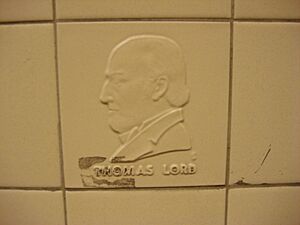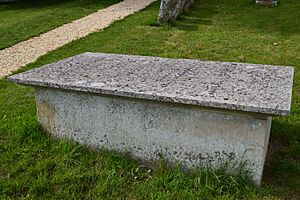Thomas Lord facts for kids

A tile with Thomas Lord's profile in relief at St John's Wood tube station
|
|||||||||||||||||||||||||||
| Personal information | |||||||||||||||||||||||||||
|---|---|---|---|---|---|---|---|---|---|---|---|---|---|---|---|---|---|---|---|---|---|---|---|---|---|---|---|
| Born | 23 November 1755 Thirsk, England |
||||||||||||||||||||||||||
| Died | 13 January 1832 (aged 76) West Meon, England |
||||||||||||||||||||||||||
| Height | 5 ft 9 in (1.75 m) | ||||||||||||||||||||||||||
| Role | Bowler | ||||||||||||||||||||||||||
| Relations | Thomas Lord jr. (Son) | ||||||||||||||||||||||||||
| Domestic team information | |||||||||||||||||||||||||||
| Years | Team | ||||||||||||||||||||||||||
| 1787–1798 | Middlesex | ||||||||||||||||||||||||||
| 1792–1797 | Marylebone Cricket Club | ||||||||||||||||||||||||||
| FC debut | 31 May 1787 Middlesex v Essex | ||||||||||||||||||||||||||
| Last FC | 14 August 1816 MCC v Middlesex | ||||||||||||||||||||||||||
| Career statistics | |||||||||||||||||||||||||||
|
|||||||||||||||||||||||||||
|
Source: ESPNcricinfo, 27 January 2016
|
|||||||||||||||||||||||||||
Thomas Lord (born November 23, 1755 – died January 13, 1832) was a famous English cricket player. He played professional cricket from 1787 to 1802. He also played one more game in 1815. Thomas Lord played in 90 important cricket matches. He was known for playing with the Middlesex team. He also worked as a bowler for the Marylebone Cricket Club (MCC). Thomas Lord is most famous for starting Lord's Cricket Ground. This is one of the most well-known cricket stadiums in the world.
Contents
Early Life of Thomas Lord
Thomas Lord was born in Thirsk, Yorkshire, England. The house where he was born is now a town museum. His father was a farmer. The family later moved to Diss, Norfolk. This is where Thomas grew up.
When he was older, Lord moved to London. He found a job at the White Conduit Club in Islington. There, he worked as a bowler and helped out generally.
Thomas Lord's Cricket Career
Thomas Lord started playing cricket around 1780. His first recorded game was on May 31, 1787. This game was played on his "own ground," which is now called Lord's Old Ground. He played for Middlesex against Essex.
Even though he is not always remembered as a great player, records show he was a very good bowler. This was especially true in the 1790s.
Founding Lord's Cricket Ground
In 1786, two important members of the White Conduit Club asked Thomas Lord for help. These were George Finch, 9th Earl of Winchilsea, and Charles Lennox, 4th Duke of Richmond. They wanted a more private place for their club to play. They promised to help Lord if he lost money.
In May 1787, Lord found a piece of land. It was about seven acres (28,000 square meters) near Dorset Square. He built his first cricket ground there. The White Conduit Club moved to this new ground. Soon after, they formed a new club, the Marylebone Cricket Club (MCC).
Moving the Cricket Ground
The lease on the first ground ended in 1810. So, Lord found new land for his cricket ground. This new place was called the Brick and Great Fields. It was in North Bank, St John's Wood. This second ground is known as Lord's Middle Ground. Games started there in 1809.
The MCC moved to the Middle Ground in 1811. But in 1813, the government needed the land for the Regent's Canal. The canal was built right through the cricket ground. This meant Lord had to move the ground again.
The Third Lord's Cricket Ground

Thomas Lord moved his cricket ground to its current location in St John's Wood. He even took the turf (grass) from the old ground with him! The new ground opened in 1814.
However, Lord was not making enough money from the ground. He wanted to build houses on part of the land. This would have left only a small area for playing cricket. To stop this, a rich MCC member named William Ward bought the ground from Lord. Ward was a great batsman and also worked at the Bank of England. He paid Lord £5,000. Even though the ownership changed, the ground is still called Lord's.
Later Life and Legacy
Thomas Lord lived in St John's Wood until 1830. Then he moved to West Meon in Hampshire. He passed away there in 1832.
His son, also named Thomas Lord, was also a first-class cricketer. Thomas Lord is buried in the churchyard of St John's Church in West Meon. There is a pub in the village named after him. West Meon is also close to Hambledon, home of the famous Hambledon Cricket Club.
Images for kids



